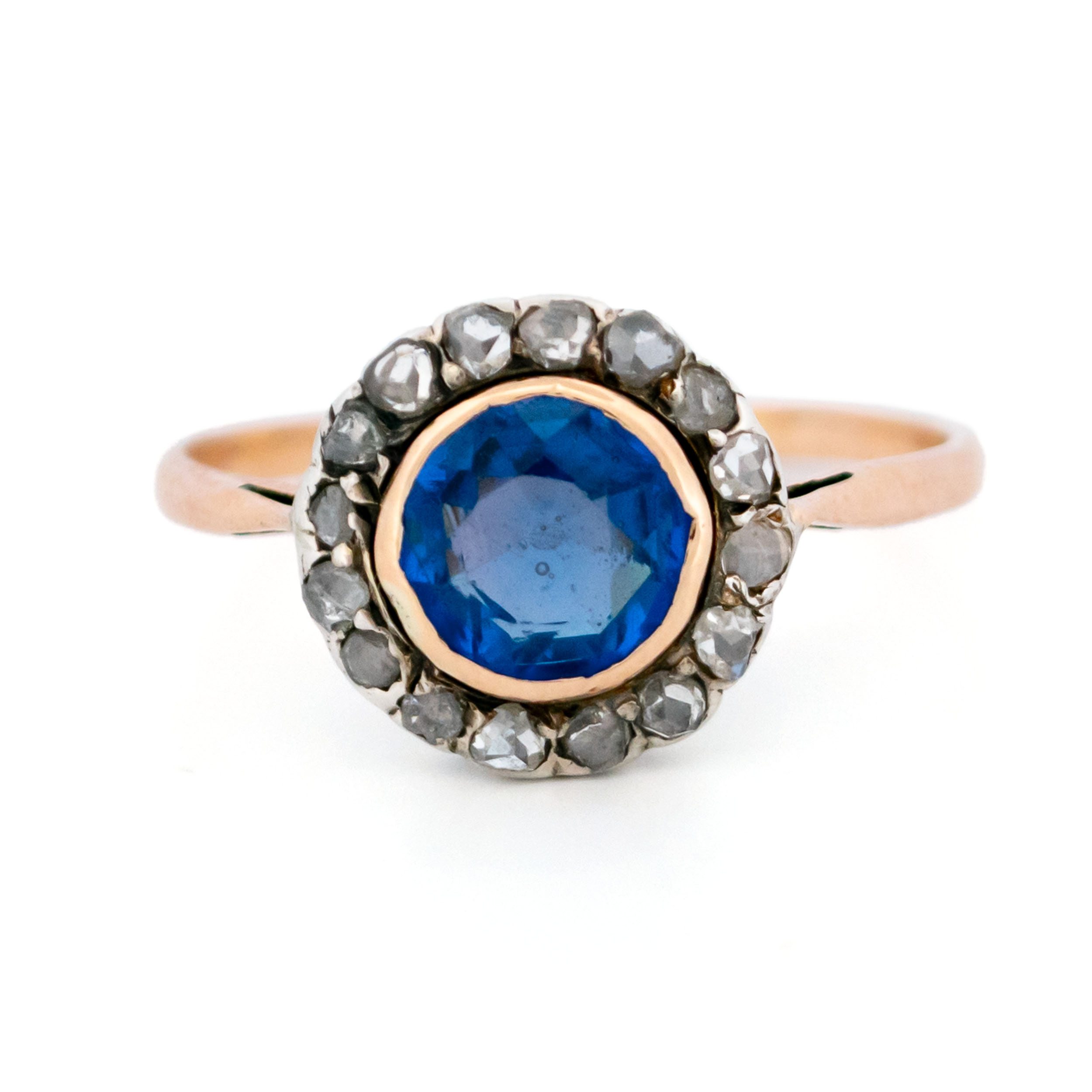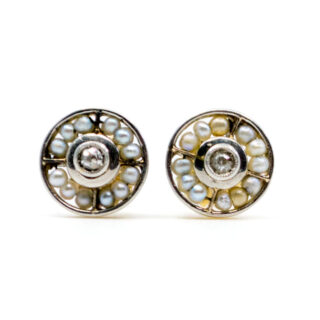✨ This cluster ring features an alluring 0.90ct round-shaped tanzanite, its vibrant color accentuated by sparkling rose-cut diamonds. Crafted in 14k gold, it boasts meticulous artistry and timeless design.
Details: ±0.90ct Tanzanite, Rose-cut diamond, 14k Ring.
Design Era: Mid 20th Century (1950-1970).
Size: 17.12 NL / 53.8 FR / 6¾ US / N UK, sizeable (Within reason. Contact seller for information).
Weight in grams: 1.7.
Condition: Vintage – used with visible signs of wear.
Shipping and Pickup: This beautiful piece ships from our store located in the center of Amsterdam, The Netherlands. We offer both registered shipping and local pickup at our store. In the case of local pickup, any applicable shipping costs will be refunded.
About Us: Add some sparkle to your style with Binenbaum.com. We offer a stunning selection of antique and vintage jewelry that you won’t find anywhere else. From timeless rings and dazzling necklaces to unique brooches, we have something for every taste and occasion. Visit our website today and treat yourself to a piece of history.
| Design Era | |
|---|---|
| Design & Historical Context | The 1950s were a time of great cultural and technological change, marked by the emergence of rock 'n' roll, the birth of the "Beat" Generation, the launch of Sputnik, and the beginning of the space race. These events, and the knowledge that the world was living in a nuclear age, contributed to the development of an aesthetic known as the "Atomic Age," which was reflected in various aspects of design, including jewelry. |
| Key Materials | |
| Materials & Craftsmanship | Tanzanite Tanzanite is a purplish blue variety of zoisite that was discovered in 1967 in Tanzania. It was introduced to the jewelry world in 1968 by Tiffany & Co., who named it "tanzanite." Tanzanite is a relatively rare gemstone that is known for its unique and striking color, which ranges from violet to blue. Tanzanite is a transparent to translucent gemstone that is often cut into a variety of different shapes, including ovals, rounds, and emerald cuts. It is also sometimes cut into cabochons, which are smooth, rounded, and dome-shaped gemstones that are polished but not faceted. Tanzanite is a relatively soft gemstone, with a hardness of 6.5 to 7 on the Mohs scale (out of 10). Despite its softness, it is still a popular choice for use in jewelry due to its unique color and rarity. Tanzanite is often associated with spiritual and emotional balance, and it is believed to have various healing properties. It is also sometimes used in meditation practices and is believed to promote calmness and tranquility. Tanzanite is often used in a variety of different types of jewelry, including rings, earrings, pendants, and bracelets. It is also sometimes used in decorative objects, such as figurines and other decorative items. Rose-cut diamond The rose cut is a type of diamond cut that was popular in the 1500s and remained common during the Georgian and Victorian eras. It is characterized by a flat bottom with a dome-shaped crown that rises to a single apex, giving the diamond a shape that resembles a rose bud. Rose cut diamonds can have anywhere from 3 to 24 facets, which are small, flat surfaces that are cut into the diamond to create a specific shape and enhance its sparkle and brilliance. Unlike modern diamond cuts, such as the round brilliant or princess cut, the rose cut has a lower crown and a less brilliant appearance. It is a more primitive diamond cut that was used before the development of more advanced cutting techniques. However, it is still a popular choice for collectors of antique jewelry and for those who appreciate the timeless beauty of vintage cuts. Rose cut diamonds are typically less expensive than diamonds with more modern cuts because they require less labor and material to produce. They are often used as accent stones in jewelry designs or as the main gemstone in vintage-style pieces. Despite their lower price, rose cut diamonds can still be beautiful and valuable, and they are a popular choice for those who appreciate the unique charm and character of antique jewelry. 14k 14k gold is a popular choice for use in jewelry because it is durable, yet still relatively affordable compared to higher karat golds like 18k or 24k. It is made up of 58.5% pure gold and is mixed with other metals to make it harder and more durable. 14k gold is available in a range of colors, including yellow, white, and rose, and is commonly used in a variety of jewelry pieces such as rings, earrings, necklaces, and bracelets. One of the advantages of 14k gold is that it is more resistant to wear and tear than pure gold, which makes it suitable for everyday wear. However, it is still softer than other alloys such as stainless steel or platinum, so it may require more maintenance to keep it looking its best. Overall, 14k gold is a popular choice for those who want the look and feel of gold, but at a more affordable price point. |
| Size | |
| Gender | |
| Weight (in grams) | 1.7 |
| Condition |
Enhance the Beauty of Your Jewelry with Proper Care
Wearing your jewelry is a special way to express yourself and add a touch of personal style to any look. However, to ensure your jewelry remains in pristine condition, there are a few simple steps you need to take to keep it looking its best.
General Care Instructions:
Remove jewelry when showering or bathing, especially when at the beach, in the sea or in chlorinated water.
Avoid wearing jewelry while doing physical work such as housekeeping, gardening or exercise.
Storing your jewelry in a dry and cool place will help protect it from moisture, dirt and dust.
Keeping it away from harsh chemicals such as bleach, ammonia and chlorine will help to avoid discoloration and damage.
Cleaning your jewelry regularly with a soft cloth will help to keep it looking shiny and new.
Avoid exposing your jewelry to extreme temperatures, such as leaving it in direct sunlight or near a heater, as this can cause damage.
Handle your jewelry carefully and avoid dropping it, as this can cause the stones to loosen or the metals to scratch.
Finally, if possible, have your jewelry professionally checked and serviced. This will ensure that any potential problems are spotted and fixed before they become worse.
By following these tips, you can enjoy your precious jewelry for many years to come.
Related products
-
Sapphire Diamond Platinum Cluster Ring 7935-4780
€ 3.995,00 VAT incl. (where applicable) -
Diamond Pearl 18k Cluster Earrings 8277-1998
€ 695,00 VAT incl. (where applicable) -
Diamond Platinum Solitaire Ring 7010-1936
€ 5.695,00 VAT incl. (where applicable) -
Moonstone Diamond Platinum Square-Shape Ring 4489-4682
€ 2.995,00 VAT incl. (where applicable) -
Diamond 14k Pear-Shape Ring 6995-1894
€ 6.695,00 VAT incl. (where applicable) -
Binenbaum Luxe Halo Ring 6966-1885
€ 5.295,00 VAT incl. (where applicable) -
Diamond Platinum Solitaire Ring 7243-1935
€ 3.995,00 VAT incl. (where applicable) -
Diamond Sapphire Platinum Target Ring 6988-0010
€ 2.295,00 VAT incl. (where applicable)
- Home
- Collection
- Fine Jewelry
- Silver Jewelry
- Silverware
- Boxes
- Candlesticks
- Salt and pepper shakers
- Miniatures
- Salt cellars
- Spoon Set
- Condiments
- Frames
- Napkin Ring
- Spoon
- Oddities
- Cups
- Vases
- Cutlery
- Serving Spoon And Cake Server
- Candlesticks
- Baskets
- Hanukkiah
- Spice Tower
- Yad
- Tea Set
- Sugar Castor
- Napkin Rings
- Wine Bottle Coaster
- Wine Stopper
- Tea Pot
- Jugs
- Rattles
- Hip Flask
- Miscellaneous
- Rings 💍
- About
- Contact






















